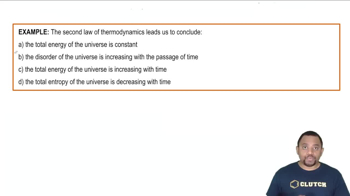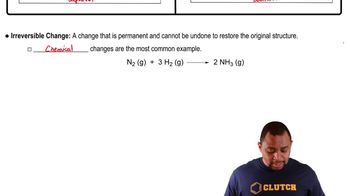The normal freezing point of n-octane (C8H18) is -57 °C. (d) Is there any temperature at which liquid n-octane and solid n-octane are in equilibrium? Explain.

Indicate whether each statement is true or false. (a) The entropy of the universe increases for any spontaneous process. (b) The entropy change of the system is equal and opposite that of the surroundings for any irreversible process. (c) The entropy of the system must increase in any spontaneous process. (d) The entropy change for an isothermal process depends on both the absolute temperature and the amount of heat reversibly transferred.
 Verified step by step guidance
Verified step by step guidanceKey Concepts
Entropy and the Second Law of Thermodynamics

Entropy Change in Irreversible Processes

Isothermal Processes and Heat Transfer

A system goes from state 1 to state 2 and back to state 1 following a reversible path in both directions. Which of the following statements about this process is or are true?
c. The value of w on going from state 1 to state 2 is equal in magnitude and opposite in sign to the value of w on going from state 2 back to state 1.
Indicate whether each statement is true or false. (a) ΔS is a state function. (b) If a system undergoes a reversible change, the entropy of the universe increases. (c) If a system undergoes a reversible process, the change in entropy of the system is exactly matched by an equal and opposite change in the entropy of the surroundings. (d) If a system undergoes a reversible process, the entropy change of the system must be zero.
The normal boiling point of Br2(l) is 58.8 °C, and its molar enthalpy of vaporization is ΔHvap = 29.6 kJ/mol. (a) When Br2(l) boils at its normal boiling point, does its entropy increase or decrease?
The normal boiling point of Br2(𝑙) is 58.8 °C, and its molar enthalpy of vaporization is Δ𝐻vap=29.6kJ/mol. (b) Calculate the value of Δ𝑆 when 1.00 mol of Br2(𝑙) is vaporized at 58.8 °C.
The element gallium (Ga) freezes at 29.8 °C, and its molar enthalpy of fusion is ΔHfus = 5.59 kJ/mol. (a) When molten gallium solidifies to Ga(s) at its normal melting point, is ΔS positive or negative?
